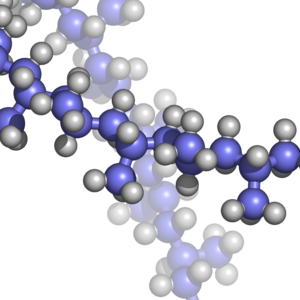 Polymers are everywhere and play a vital role in our everyday lives. Highly engineered multilayer polymer films are used in food packaging to ensure freshness. High strength polymer fibers are used in seat belts keeping us safe in the event of a crash. We rely on plastic containers of all types in our everyday lives. Need to fix a broken part? You can use ultra fast curing Crazy Glue (cyanoacrylates) or go down to Home Depot and pick up a two part 5 minute epoxy. These types of polymers are formed during curing and have unique properties due to their crosslinked network structure. Did you know that most semiconductor chips in your iPhone or computer are actually glued to either a metal or polymer substrate using sophisticated adhesives that are electrically conductive? Reactive chemistries (epoxy, acrylate, bismaleimide and others) are widely used in adhesives since they start as small molecules (easy to dispense) and on curing react into a solid, high strength adhesive. Recently I visited my father-in-law’s farm in central Illinois. Big Sky Wind, LLC is constructing a wind farm with 114 turbines. Two will be on his farm. I got a close look at the blades. Amazing. There are three blades per turbine and are 142 feet long. What are they made of? You guessed it, polymer composites. In this case, the polymers are not used alone, but are mixed with reinforcing glass cloth to form a fiberglass composite. I will have more on wind turbine blade production in a subsequent post. The new Boeing Dreamliner 787 is the first commercial airplane to have a composite fuselage.
Polymers are everywhere and play a vital role in our everyday lives. Highly engineered multilayer polymer films are used in food packaging to ensure freshness. High strength polymer fibers are used in seat belts keeping us safe in the event of a crash. We rely on plastic containers of all types in our everyday lives. Need to fix a broken part? You can use ultra fast curing Crazy Glue (cyanoacrylates) or go down to Home Depot and pick up a two part 5 minute epoxy. These types of polymers are formed during curing and have unique properties due to their crosslinked network structure. Did you know that most semiconductor chips in your iPhone or computer are actually glued to either a metal or polymer substrate using sophisticated adhesives that are electrically conductive? Reactive chemistries (epoxy, acrylate, bismaleimide and others) are widely used in adhesives since they start as small molecules (easy to dispense) and on curing react into a solid, high strength adhesive. Recently I visited my father-in-law’s farm in central Illinois. Big Sky Wind, LLC is constructing a wind farm with 114 turbines. Two will be on his farm. I got a close look at the blades. Amazing. There are three blades per turbine and are 142 feet long. What are they made of? You guessed it, polymer composites. In this case, the polymers are not used alone, but are mixed with reinforcing glass cloth to form a fiberglass composite. I will have more on wind turbine blade production in a subsequent post. The new Boeing Dreamliner 787 is the first commercial airplane to have a composite fuselage.
So where did this all start? Wallace H. Carothers was an incredibly talented chemist at DuPont Chemical in the early 1930’s. He is largely responsible for what is the polymer industry today and is credited with the invention of neoprene and nylon. Carothers invented neoprene in 1931 and nylon in 1934. It was the invention of nylon and the subsequent breakthrough in making nylon fiber that revolutionized the industry. Carothers and his team at DuPont developed the polymerization and fiber spinning process enabling the production of highly oriented nylon fibers with more elasticity and high strength. Nylon fibers where then used to make a wide variety of fabrics. Nylon was an instant best seller in 1940 when DuPont began making women’s “nylons.” The rest as they say “is history.” Nylon became very important during the Second World War. The military used it in 3.8 million parachutes, a half a million air plane tires, uncounted numbers of glider tow ropes, flask vests, and blood plasma filters.
After the World War II, the advances in polymer science accelerated at an amazing pace. You might not have realized this, but the synthetic polymer industry is relatively young compared to ceramics and metal uses going back several thousand years. In subsequent posts, we will explore the role of innovation in polymers and highlight some current new applications and trends.

Leave a Reply